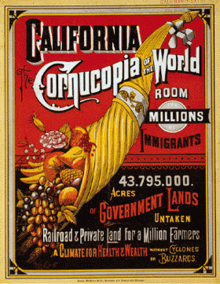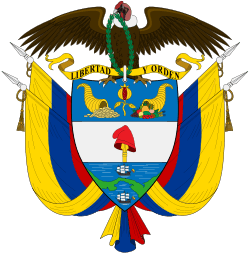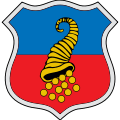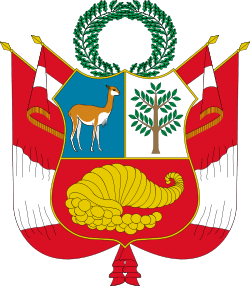Cornucopia
_-_Google_Art_Project.jpg)
The cornucopia (from Latin cornu copiae) or horn of plenty is a symbol of abundance and nourishment, commonly a large horn-shaped container overflowing with produce, flowers or nuts. The horn originates from classical antiquity, it has continued as a symbol in Western art, and it is particularly associated with the Thanksgiving holiday in North America.
In mythology



Mythology offers multiple explanations of the origin of the cornucopia. One of the best-known involves the birth and nurturance of the infant Zeus, who had to be hidden from his devouring father Kronus. In a cave on Mount Ida on the island of Crete, baby Zeus was cared for and protected by a number of divine attendants, including the goat Amalthea ("Nourishing Goddess"), who fed him with her milk. The suckling future king of the gods had unusual abilities and strength, and in playing with his nursemaid accidentally broke off one of her horns, which then had the divine power to provide unending nourishment, as the foster mother had to the god.[1]
In another myth, the cornucopia was created when Heracles (Roman Hercules) wrestled with the river god Achelous and wrenched off one of his horns; river gods were sometimes depicted as horned.[2] This version is represented in the Achelous and Hercules mural painting by the American Regionalist artist Thomas Hart Benton.
The cornucopia became the attribute of several Greek and Roman deities, particularly those associated with the harvest, prosperity, or spiritual abundance, such as personifications of Earth (Gaia or Terra); the child Plutus, god of riches and son of the grain goddess Demeter; the nymph Maia; and Fortuna, the goddess of luck, who had the power to grant prosperity. In Roman Imperial cult, abstract Roman deities who fostered peace (pax Romana) and prosperity were also depicted with a cornucopia, including Abundantia, "Abundance" personified, and Annona, goddess of the grain supply to the city of Rome. Pluto, the classical ruler of the underworld in the mystery religions, was a giver of agricultural, mineral and spiritual wealth, and in art often holds a cornucopia to distinguish him from the gloomier Hades, who holds a drinking horn instead.[3]
Modern depictions
In modern depictions, the cornucopia is typically a hollow, horn-shaped wicker basket filled with various kinds of festive fruit and vegetables. In most of North America, the cornucopia has come to be associated with Thanksgiving and the harvest. Cornucopia is also the name of the annual November Food and Wine celebration in Whistler, British Columbia, Canada. Two cornucopias are seen in the flag and state seal of Idaho. The Great Seal of North Carolina depicts Liberty standing and Plenty holding a cornucopia. The coat of arms of Colombia, Panama, Peru and Venezuela, and the Coat of Arms of the State of Victoria, Australia, also feature the cornucopia, symbolising prosperity. In the book and film series The Hunger Games, the Cornucopia is filled with weapons, and is the starting point of the Games, and it is also the name of the Anthem of Panem.
The horn of plenty is used for body art and at Halloween, as it is a symbol of fertility, fortune and abundance.[4]
Gallery

 Angel with cornucopia
Angel with cornucopia Base of a statue of
Base of a statue of
Louis XV of France

 Cornucopia as an object used in interior decoration
Cornucopia as an object used in interior decoration Allegory of peace and happiness of the state. Eirene with cornucopia
Allegory of peace and happiness of the state. Eirene with cornucopia

 Cornucopia in the Statue of Flora in Szczecin, Poland
Cornucopia in the Statue of Flora in Szczecin, Poland
See also
References
| Wikimedia Commons has media related to Cornucopia. |
- ↑ David Leeming, The Oxford Companion to World Mythology (Oxford University Press, 2005), p. 13; Robert Parker, Polytheism and Society at Athens (Oxford University Press, 2005), p. 422.
- ↑ Ovid, Metamorphoses 9.87–88, as cited by J. Rufus Fears, "The Cult of Virtues and Roman Imperial Ideology," Aufstieg und Niedergang der römischen Welt II.17.2 (1981), p. 821.
- ↑ Kevin Clinton, Myth and Cult: The Iconography of the Eleusinian Mysteries (Stockholm, 1992), pp. 105–107.
- ↑ Hastings, James (ed.). Encyclopaedia of Religion and Ethics.